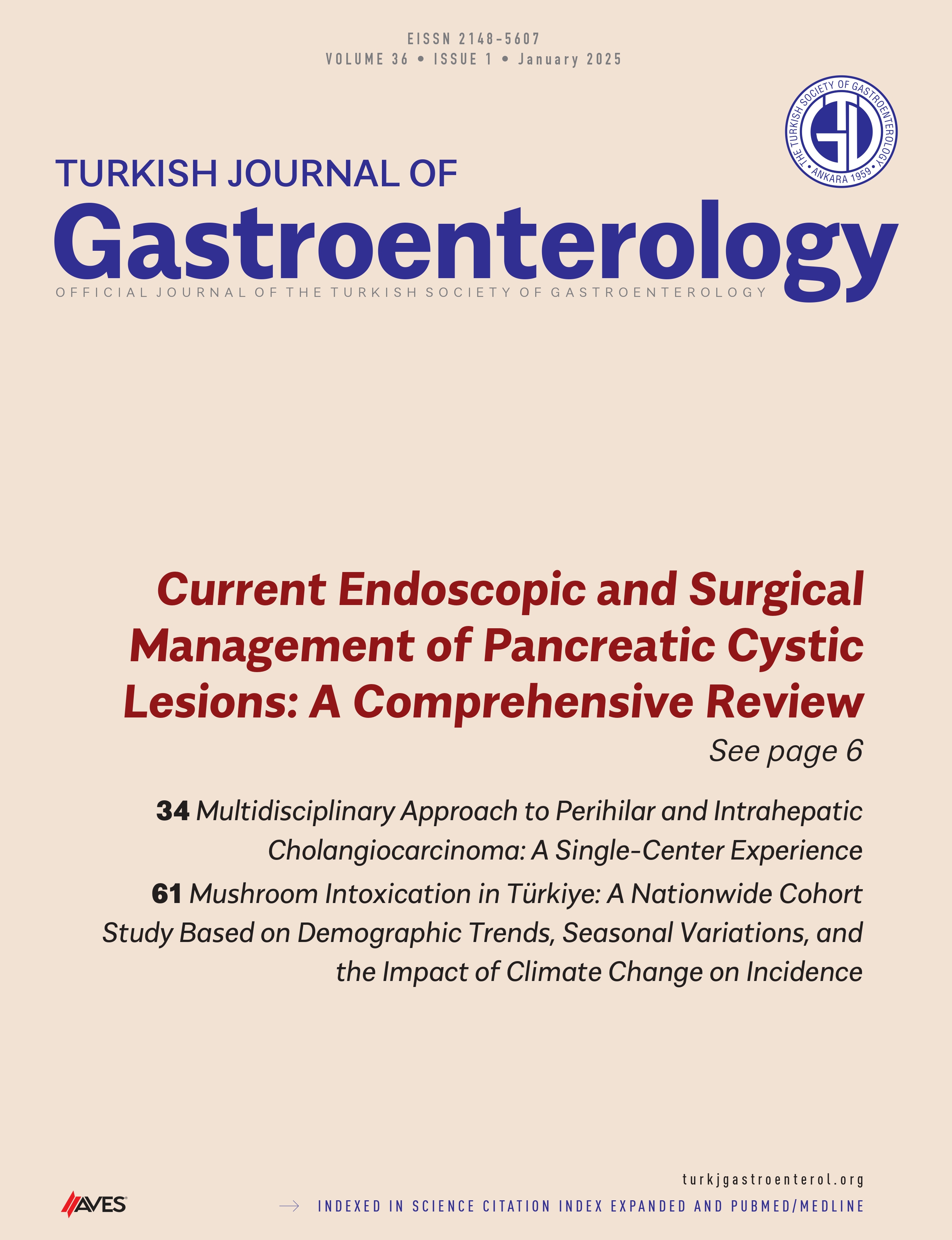Mushroom Intoxication in Türkiye: A Nationwide Cohort Study Based on Demographic Trends, Seasonal Variations, and the Impact of Climate Change on Incidence
Main Article Content
Abstract
Background/Aims: Mushroom intoxication poses a considerable public health risk due to its potential for severe toxicity and fatality. This study aims to investigate demographic trends, diagnostic locations, and mortality rates of patients with mushroom intoxication.
Materials and Methods: This retrospective cohort study utilized data from the National Electronic Database of the Turkish Ministry of Health. The study focused on patients without chronic liver disease or prior liver transplantation presenting with mushroom intoxication between 2018 and 2023. Demographic information, diagnostic locations, and mortality rates were analyzed, considering a six-year period to ensure even seasonal distribution.
Results: Among 30459 individuals admitted with mushroom intoxication, 44.75% were male, with a mean age of 45.84 years. The Black Sea, Marmara, and Central Anatolia regions had the highest number of cases, with specific cities like Tokat, Bolu, Yozgat, and Kastamonu having the highest rates per 100,000 population in 2022. Mushroom intoxication predominantly occurred in May, June, October, and November. Hospitalization occurred in 8.9% of cases, with a 6.6% mortality rate within 90 days and 1.3% progressing to liver transplantation. Notably, mushroom intoxication cases increased by 130% in the first half of 2023, particularly in May and June, correlating with increased rainfall.
Conclusion: Mushroom intoxication is a serious public health issue, with morbidity and mortality influenced by climate factors. The study highlights a significant increase in cases in the first half of 2023, potentially linked to heightened rainfall and climate change.
Cite this article as: Turan Gökçe D, Arı D, Ata N, et al. Mushroom intoxication in Türkiye: a nationwide cohort study based on demographic trends, seasonal variations, and the impact of climate change on incidence. Turk J Gastroenterol. 2025;36(1):61-66.
Article Details
References
1. Diaz JH. Amatoxin-containing mushroom intoxications: species, toxidromes, treatments, and outcomes. Wilderness Environ Med. 2018;29(1):111-118. [CrossRef]
2. Jo WS, Hossain MA, Park SC. Toxicological profiles of poisonous, edible, and medicinal mushrooms. Mycobiology. 2014;42(3):215-220. [CrossRef]
3. Graeme KA. Mycetism: a review of the recent literature. J Med Toxicol. 2014;10(2):173-189. [CrossRef]
4. Patočka J, Wu R, Nepovimova E, Vališ M, Wu W, Kuca K. Chemistry and toxicology of major bioactive substances in inocybe mushrooms. Int J Mol Sci. 2021;22(4):2218. [CrossRef]
5. Garcia J, Costa VM, Carvalho A, et al. Amanita phalloides intoxication: mechanisms of toxicity and treatment. Food Chem Toxicol. 2015;86:41-55. [CrossRef]
6. Kaya E, Hancı M, Karahan S, Bayram S, Yaykaşlı KO, Sürmen MG. Thermostability of alpha amanitin in water and methanol. Eur J Basic Med Sci. 2012;2(4):106-111. [CrossRef]
7. Çelik F, Ünal NG, Şenkaya A, et al. Outcomes of patients with acute hepatotoxicity caused by mushroom-induced intoxication. Turk J Gastroenterol. 2021;32(8):678-684. [CrossRef]
8. Pennisi L, Lepore A, Gagliano-Candela R, Santacroce L, Charitos IA. A report on mushrooms poisonings in 2018 at the Apulian regional poison center. Open Access Maced J Med Sci. 2020;8(E):616-622. [CrossRef]
9. Gawlikowski T, Romek M, Satora L. Edible mushroom-related intoxication. Hum Exp Toxicol. 2014;34(7):718-724. [CrossRef]
10. Brandenburg WE, Ward KJ. Mushroom intoxication epidemiology in the United States. Mycologia. 2018;110(4):637-641. [CrossRef]
11. Assisi F, Davanzo F, Bissoli M, et al. Epidemiology and clinical aspect of mushroom intoxication in Italy: a 20-year retrospective analysis (1998-2017) of data from the Milan Poison Control Centre. Inserto BEN-Boll Epidemiologico Naz. 2019;32(4):5-9.
12. Erguven M, Yilmaz O, Deveci M, et al. Mushroom intoxication. Indian J Pediatr. 2007;74(9):847-852. [CrossRef]
13. Janatolmakan M, Jalilian M, Rezaeian S, Alireza A, Alireza K. Mortality rate and liver transplant in patients with mushroom intoxication: a systematic review & meta-analysis. Heliyon. 2023;9(1):e12759. [CrossRef]
14. Krebs CJ, Carrier P, Boutin S, Boonstra R, Hofer E. Mushroom crops in relation to weather in the southwestern Yukon. Botany. 2008;86(12):1497-1502. [CrossRef]
15. Republic of Türkiye Ministry of Environment, Urbanization and Climate Change, General Directorate of Meteorology. Annual and Seasonal Precipitation Evaluation Data. 2023.
16. Turkish State Meteorological Service. Annual areal precipitation throughout Türkiye. 2023, Available at: https://www.mgm.gov.tr/veridegerlendirme/yillik-toplam-yagis-verileri.aspx.


